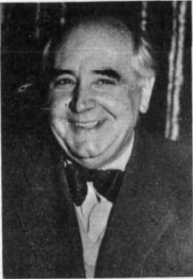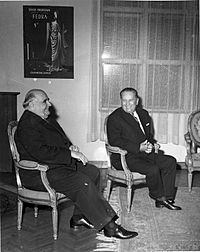Miroslav Krleža facts for kids
Quick facts for kids
Miroslav Krleža
|
|
|---|---|

Miroslav Krleža in 1953
|
|
| Born | 7 July 1893 Zagreb, Kingdom of Croatia-Slavonia, Austria-Hungary |
| Died | 29 December 1981 (aged 88) Zagreb, SR Croatia, SFR Yugoslavia |
| Occupation | Novelist, playwright, poet, philosopher, essayist, cultural critic |
| Language | Croatian |
| Nationality | Croat |
| Period | 1915–77 |
| Literary movement | Expressionism, Socialist realism |
| Notable works | Gospoda Glembajevi Hrvatski bog Mars Balade Petrice Kerempuha Povratak Filipa Latinovicza Banket u Blitvi Zastave |
| Spouse | Bela Krleža |
Miroslav Krleža (born July 7, 1893 – died December 29, 1981) was a very important writer from Croatia and Yugoslavia. He is often called the greatest Croatian writer of the 20th century. He was famous in both the Kingdom of Yugoslavia (1918–1941) and the Socialist Republic of Yugoslavia (1945–1981). He was also a leader in cultural life.
Contents
Miroslav Krleža's Life Story
Miroslav Krleža was born in Zagreb, which is now the capital of Croatia. When he was young, he went to a military school in Pécs, a city in modern-day Hungary. At that time, both Pécs and Zagreb were part of the large Austro-Hungarian Empire.
Later, he attended another military academy in Budapest. During World War I, he tried to join Serbia's army but was suspected of being a spy. When he returned to Croatia, he was sent to fight on the Eastern Front as a regular soldier. After World War I, Krleža became a well-known writer. He was also a strong voice in the new country of Yugoslavia. This country included lands that were once part of the Austro-Hungarian Empire, along with Serbia and Montenegro.
Krleža's Ideas and Politics
Krleža started several important magazines where he shared his ideas. These included Plamen (The Flame) in 1919, Književna republika (Literary Republic) from 1923 to 1927, Danas (Today) in 1934, and Pečat (Seal) from 1939 to 1940.
He joined the Communist Party of Yugoslavia in 1918. However, he was later removed from the party in 1939. This happened because he had different ideas about art and believed artists should have freedom to express themselves. He disagreed with the party's strict rules for art. He also didn't fully support some of the party's harsh actions. These disagreements led to a long debate among writers. Josip Broz Tito, who later became the leader of Yugoslavia, even tried to help solve these arguments.
Life After World War II
After World War II, a new government was formed in Croatia. Krleža did not immediately join the Partisans, who were led by Tito. For a short time after 1945, he faced some challenges. However, he soon became a very important person. He was a vice-president of the Yugoslav Academy of Science and Arts in Zagreb. His collected works were also published by a major state publishing house.
With support from Tito, Krleža started the Yugoslav Institute for Lexicography in 1950. This institute creates dictionaries and encyclopedias. He led it until he passed away. After his death, the institute was named after him. It is now called the Miroslav Krleža Institute of Lexicography.
From 1950 onwards, Krleža was a highly respected writer and thinker. He was often close to Tito. He also served as the president of the Yugoslav writers' union for a few years. He received important awards for his writing, like the NIN Award in 1962 for his novel Zastave, and the Herder Prize in 1968.
Miroslav Krleža became ill in his later years, especially after Tito died in 1980 and his wife, Bela Krleža, died in 1981. He received the Laureate Of The International Botev Prize in 1981. He passed away in his home in Zagreb on December 29, 1981. He was given a state funeral in Zagreb on January 4, 1982.
Miroslav Krleža's Works

Krleža was influenced by many different types of art and literature. He liked plays from Scandinavia, French symbolism (which uses symbols to represent ideas), and German expressionism (which shows emotions rather than reality). Some of the key writers who influenced him were Henrik Ibsen, August Strindberg, Friedrich Nietzsche, Karl Kraus, Rainer Maria Rilke, and Marcel Proust.
Krleža wrote many different kinds of works. They can be grouped into these categories:
Poetry
While Krleža's lyric poetry is highly valued, his most famous poetic work is Balade Petrice Kerempuha (Ballads of Petrica Kerempuh). This long poem covers more than five centuries of history. It focuses on a character named "Petrica Kerempuh," who is like a Croatian folk hero.
Novels
Krleža wrote four main novels:
- Povratak Filipa Latinovicza (The Return of Philip Latinowicz) is about an artist.
- Na rubu pameti (On the Edge of Reason) and Banket u Blitvi (The Banquet in Blitva) are political stories. They talk about ideas and the feeling of totalitarianism, where the government has complete control. The Banquet in Blitva is set in an imaginary country.
- Zastave (The Banners) is a very long novel. It is sometimes called a "Croatian War and Peace." It shows a wide view of Croatian society before, during, and after World War I. It also explores the common theme of fathers and sons having conflicts.
All of Krleža's novels, except Zastave, have been translated into English.
Short Stories
One of Krleža's most important collections of short stories is the anti-war book Hrvatski bog Mars (Croatian God Mars). These stories are about the difficult experiences of Croatian soldiers during World War I.
Plays
Krleža was very interested in writing plays. He started with experimental plays like Adam i Eva and Michelangelo Buonarroti. These plays explored the strong feelings of heroic people. Later, he wrote more traditional plays. His most famous play is Gospoda Glembajevi (The Glembays). This play is part of a series that shows the decline of a wealthy family. Golgota is another play he wrote, which has a political theme.
Diaries and Memoirs
Krleža's diaries and memoirs are fascinating. They include Davni dani (Olden days) and Djetinjstvo u Agramu (Childhood in Zagreb). These writings show how he grew and learned about himself and the world. Other important works, like Dnevnici (Diaries) and Zapisi iz Tržiča (Notes from Tržič), were published after he died. They contain his thoughts and observations on art, politics, literature, society, and philosophy over more than fifty years.
Selected Works
- Hrvatski bog Mars (1922)
- Gospoda Glembajevi (1928)
- Povratak Filipa Latinovicza (1932)
- Balade Petrice Kerempuha (1936)
- Banket u Blitvi (1939)
- Zastave (1962)
Some of his works have been translated into English:
- The Banquet in Blitva (1939)
- The Cricket Beneath the Waterfall, and Other Stories
- Harbors Rich in Ships: Selected Revolutionary Writings
- Journey to Russia (1925)
- On the Edge of Reason (1938)
- The Return of Philip Latinowitz (1932)
See also
 In Spanish: Miroslav Krleža para niños
In Spanish: Miroslav Krleža para niños


